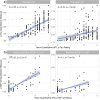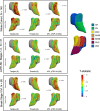Association of quantitative histopathology measurements with antemortem medial temporal lobe cortical thickness in the Alzheimer's disease continuum
- PMID: 39227502
- PMCID: PMC11371872
- DOI: 10.1007/s00401-024-02789-9
Association of quantitative histopathology measurements with antemortem medial temporal lobe cortical thickness in the Alzheimer's disease continuum
Abstract
The medial temporal lobe (MTL) is a hotspot for neuropathology, and measurements of MTL atrophy are often used as a biomarker for cognitive decline associated with neurodegenerative disease. Due to the aggregation of multiple proteinopathies in this region, the specific relationship of MTL atrophy to distinct neuropathologies is not well understood. Here, we develop two quantitative algorithms using deep learning to measure phosphorylated tau (p-tau) and TDP-43 (pTDP-43) pathology, which are both known to accumulate in the MTL and are associated with MTL neurodegeneration. We focus on these pathologies in the context of Alzheimer's disease (AD) and limbic predominant age-related TDP-43 encephalopathy (LATE) and apply our deep learning algorithms to distinct histology sections, on which MTL subregions were digitally annotated. We demonstrate that both quantitative pathology measures show high agreement with expert visual ratings of pathology and discriminate well between pathology stages. In 140 cases with antemortem MR imaging, we compare the association of semi-quantitative and quantitative postmortem measures of these pathologies in the hippocampus with in vivo structural measures of the MTL and its subregions. We find widespread associations of p-tau pathology with MTL subregional structural measures, whereas pTDP-43 pathology had more limited associations with the hippocampus and entorhinal cortex. Quantitative measurements of p-tau pathology resulted in a significantly better model of antemortem structural measures than semi-quantitative ratings and showed strong associations with cortical thickness and volume. By providing a more granular measure of pathology, the quantitative p-tau measures also showed a significant negative association with structure in a severe AD subgroup where semi-quantitative ratings displayed a ceiling effect. Our findings demonstrate the advantages of using quantitative neuropathology to understand the relationship of pathology to structure, particularly for p-tau, and motivate the use of quantitative pathology measurements in future studies.
Keywords: Alzheimer’s disease; Quantitative neuropathology; TDP-43; Tau.
© 2024. The Author(s).
Conflict of interest statement
D.A.W has served as a paid consultant to Eli Lilly, GE Healthcare, and Qynapse. He serves on a DSMB for Functional Neuromodulation and GSK. He is a site investigator for a clinical trial sponsored by Biogen. D.J.I. is member of science advisory board of Denali Therapeutics. S.R.D. received consultation fees from Rancho Biosciences and Nia Therapeutics. The other authors have nothing to disclose.
Figures







References
Publication types
MeSH terms
Substances
Grants and funding
- R01-NS109260/NS/NINDS NIH HHS/United States
- T32 AG076411/AG/NIA NIH HHS/United States
- P01 AG084497/AG/NIA NIH HHS/United States
- R25-NS065745/NS/NINDS NIH HHS/United States
- AACSF-23-1152241/ALZ/Alzheimer's Association/United States
- R01 AG070592/AG/NIA NIH HHS/United States
- RF1 AG056014/AG/NIA NIH HHS/United States
- R01 AG056014/AG/NIA NIH HHS/United States
- R01 AG069474/AG/NIA NIH HHS/United States
- U19 AG062418/AG/NIA NIH HHS/United States
- R25 NS065745/NS/NINDS NIH HHS/United States
- P30 AG072979/AG/NIA NIH HHS/United States
- AARF-21- 48972/ALZ/Alzheimer's Association/United States
- R01 AG075276/AG/NIA NIH HHS/United States
- P01 AG066597/AG/NIA NIH HHS/United States
- RF1 AG069474/AG/NIA NIH HHS/United States
- R01 NS109260/NS/NINDS NIH HHS/United States
LinkOut - more resources
Full Text Sources
Medical

